Introduction
In the ever-evolving landscape of technology, the Internet of Things (IoT) has emerged as a transformative force, reshaping industries and daily life. At the intersection of this technological revolution lies the domain of education, particularly language learning.
The integration of IoT in language learning is not just a fleeting trend but a robust approach to making language acquisition more interactive, personalized, and effective.
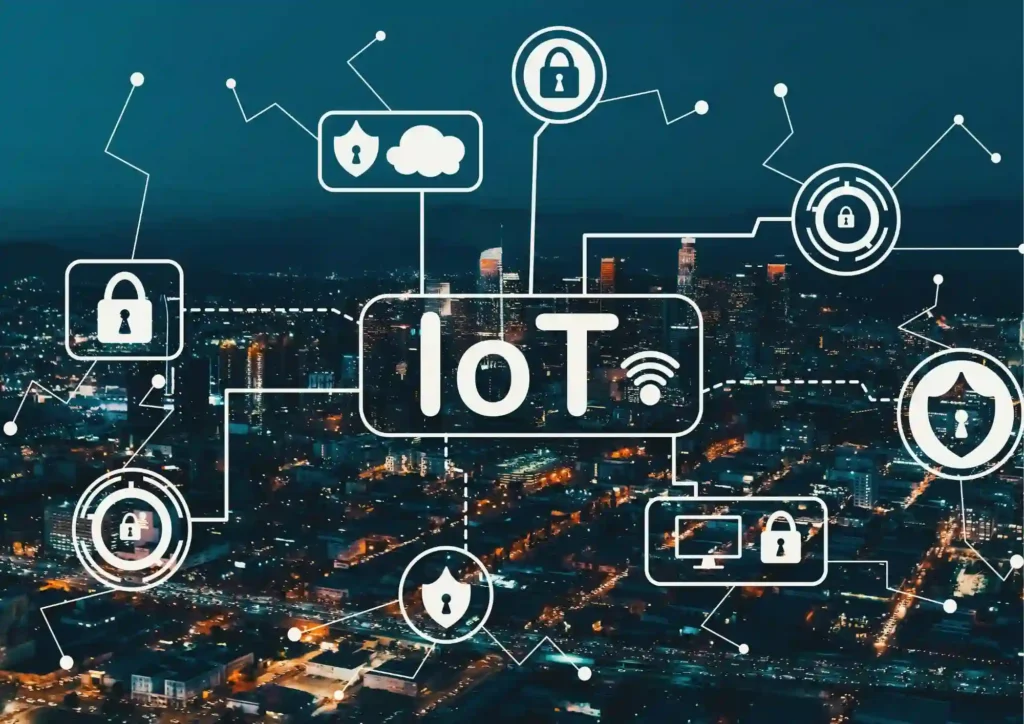
The concept of IoT involves the interconnectivity of physical devices, vehicles, home appliances, and other items embedded with electronics, software, sensors, actuators, and connectivity which enables these objects to connect and exchange data.
This network of connected objects offers a wealth of opportunities for enhancing the educational experience.
As we delve into the realm of IoT for language learning, we uncover a world where traditional textbooks and audio tapes give way to smart devices that interact with learners in real time, adapting to their individual needs and providing immediate feedback.
This blog post aims to explore the myriad ways in which IoT is revolutionizing language learning, offering insights into its benefits, challenges, and future potential.
Let’s embark on this journey to understand how IoT for language learning can unlock new potentials and redefine the way we learn languages.
Understanding IoT and Its Impact on Education
What is IoT?
The Internet of Things (IoT) refers to a vast network of devices that are connected to the Internet, capable of collecting and sharing data without human intervention. From smart thermostats in homes to sensors in industrial machinery, IoT is the invisible yet omnipresent web that binds the digital and physical worlds together.
The Role of IoT in Educational Settings
In educational settings, IoT has the potential to create dynamic learning environments that respond to the needs of students in real time.
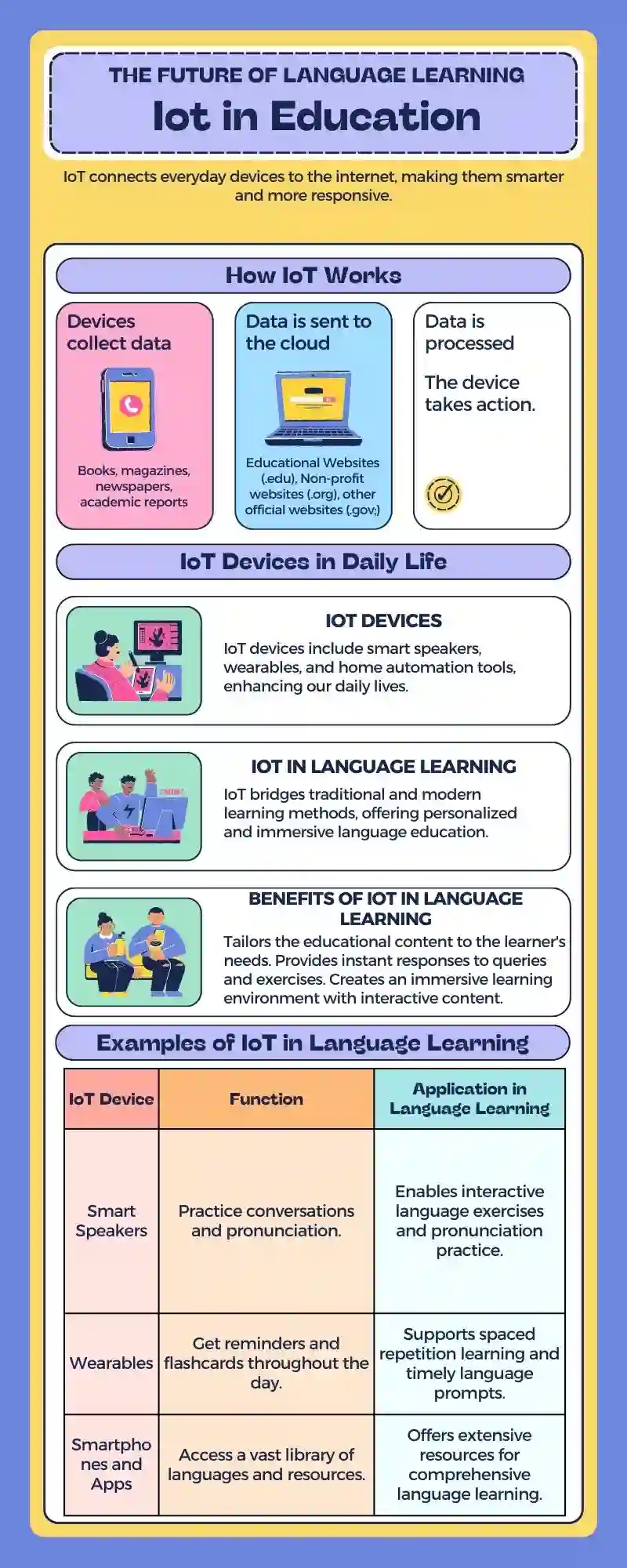
For instance, smart boards can adjust the difficulty level of a lesson based on the class’s performance, or language labs can use voice recognition to correct pronunciation errors instantly.
Key Benefits of IoT in Education:
- Enhanced Engagement: Interactive IoT devices can make learning more engaging by providing hands-on experiences.
- Efficiency: Automation of administrative tasks allows teachers to focus more on teaching and less on paperwork.
- Personalization: IoT can tailor educational content to match the learning pace and style of each student.
Challenges to Consider:
- Security: With increased connectivity comes the risk of data breaches and privacy concerns.
- Infrastructure: Schools need the proper infrastructure to support IoT, which can be costly.
By understanding the fundamentals of IoT and its implications for education, we can better appreciate its role in language learning, which we will explore in the next section.
The Intersection of IoT and Language Learning
Enhancing Language Acquisition with IoT
IoT devices are not just smart; they’re also becoming linguistically savvy. They can play a significant role in language acquisition by providing immersive, contextual learning experiences.
For example, smart speakers can converse with learners in a foreign language, while IoT-enabled toys can teach children new words through interactive play.
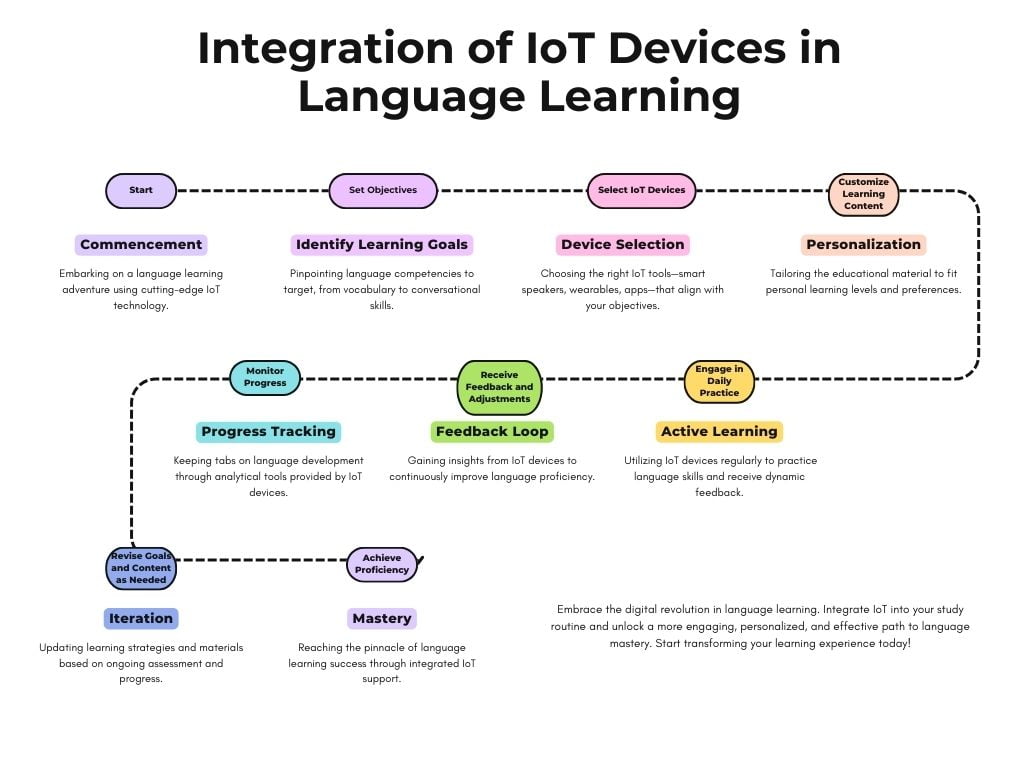
Case Study 1: Enhancing English Language Diction and Speech with IoT
Overview
This case study focuses on an interactive teaching model for the English language, utilizing IoT to enhance the learning process. The model employed various sensors to improve learners’ diction and speech by comparing them to standard pronunciations and accents.
Implementation
The system used video sensors for diction acquisition and analysis in English learners, along with voice sensors for speech acquisition and computer analysis.
These sensors allowed students to make quicker and more accurate judgments in their language learning process.
Results
The experimental results showed that the IoT-based interactive teaching model was highly effective in improving English education. It facilitated active judgments more quickly and automatically, enhancing both the teaching and learning experience
IoT-Driven Language Learning Methodologies
The methodologies for language learning are evolving with IoT. Gone are the days of rote memorization; now, learners can engage with IoT devices that make use of natural language processing to facilitate more natural and intuitive learning experiences.
List of Methodologies:
- Task-Based Learning: IoT devices can set tasks for learners to complete in the target language, such as navigating a smart home.
- Immersive Experiences: Virtual reality (VR) headsets can transport learners to environments where they must use the target language to interact.
Benefits:
- Real-World Practice: IoT offers opportunities for learners to practice language in real-world scenarios.
- Instant Feedback: Devices can provide immediate corrections and suggestions, speeding up learning.
Challenges:
- Technological Limitations: Not all IoT devices are equipped for complex language tasks.
- Language Complexity: IoT may struggle with the nuances and complexities of human languages.
Integrating IoT into language learning can create a more engaging and effective educational experience. The next section will delve into the tools and technologies that make this possible.
IoT Tools and Technologies for Language Learners
Innovative IoT Devices for Language Practice
The market is brimming with IoT devices that are designed to make language learning more interactive and fun. These range from smart pens that can translate written text on the fly to wearable devices that assist with pronunciation and vocabulary.
Examples of IoT Devices:
- Smart Pens: Devices like the Scanmarker Air can scan printed text and translate it into the language of choice.
- Wearable Tech: Gadgets such as the WT2 language translator earbuds provide real-time translation for conversations.
Software and Applications
Alongside hardware, there’s a plethora of software solutions that leverage IoT to enhance language learning. These applications can track progress, suggest personalized content, and even connect learners with native speakers.
List of Applications:
- Duolingo: Utilizes IoT by syncing progress across devices and providing personalized learning paths.
- HelloTalk: Connects learners with native speakers using IoT-enabled communication tools.
Benefits:
- Convenience: Learn anytime, anywhere, with IoT-enabled devices.
- Interactivity: Engage with languages in new, exciting ways.
Challenges:
- Device Dependency: Reliance on electronic devices may limit traditional learning methods.
- Software Limitations: Not all languages are supported equally by IoT applications.
As we continue to explore the benefits and challenges of IoT in language learning, we can see how these tools and technologies are shaping the future of education.
| IoT Device | Primary Function | Expanded Application in Language Learning |
|---|---|---|
| Smart Speakers | Practice conversations and pronunciation. | Interactive Exercises: Voice-activated tasks for skill improvement. Language Support: List of languages available. Customization: Proficiency and goal settings. Additional Features: Translation services and device compatibility. User Experience: Testimonials on effectiveness. |
| Wearables | Get reminders and flashcards throughout the day. | Learning On-the-Go: Incorporates learning seamlessly into daily life. Progress Tracking: Monitors and reports advancements. User Interface: User-friendly design and interaction. Battery Life & Durability: Details for everyday usage. Social Integration: Features for community engagement and sharing. |
| Smartphones and Apps | Access a vast library of languages and resources. | Content Variety: Extensive range of multimedia learning materials. Offline Accessibility: Functionality without internet. Cost: Overview of free and premium features. Community and Support: Access to support networks and services. Updates and Development: Information on update frequency and new content. |
Case Study 2: Empowering English Translation Learning with IoT and Big Data
Overview
The second case study investigated the development of an English translation learning system using big data analysis and IoT. The aim was to enhance students’ comprehension and proficiency in translation by providing a more effective learning environment.
Implementation
The system proposed a client/server (C/S) learning system for English translation on Android devices, designed using a model–view–controller architecture. It utilized a three-layer IoT architecture to facilitate wireless connections among devices, network translation servers, and speech synthesis servers.
Results
The study applied an enhanced fuzzy c-means clustering algorithm to analyze English translation learning data, achieving high data classification accuracy. This significantly enhanced the effectiveness and learning outcomes of English translation education.
The Benefits of IoT in Language Learning
Personalized Learning Experiences
One of the most significant advantages of IoT for language learning is the ability to create personalized learning experiences. IoT devices can collect data on a learner’s performance and tailor the content to their proficiency level, learning pace, and preferred learning style.
Key Points:
- Adaptive Learning: IoT devices can adjust the difficulty of exercises in real time based on the learner’s responses.
- Customized Feedback: Learners receive personalized feedback, helping them focus on areas that need improvement.
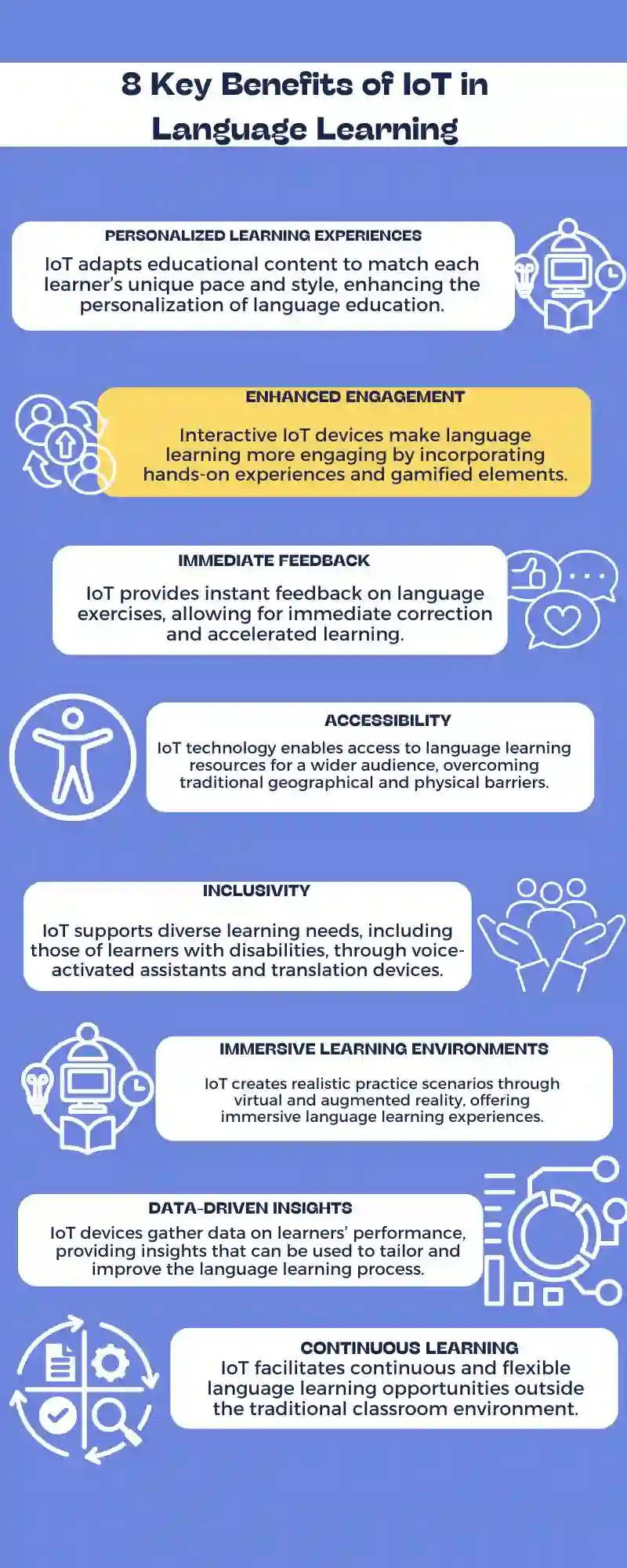
Accessibility and Inclusivity
IoT also makes language learning more accessible and inclusive, breaking down geographical and physical barriers. It enables learners from all over the world to access high-quality language education, regardless of their location or mobility.
List of Accessibility Features:
- Voice-Activated Assistants: Help those with physical disabilities to learn languages without the need for typing or writing.
- Translation Devices: Allow learners to understand and communicate in multiple languages instantly.
Challenges:
- Digital Divide: Not everyone has equal access to IoT devices, which can create disparities in learning opportunities.
- Complexity: Some learners may find it challenging to navigate the plethora of IoT devices and platforms available.
By leveraging the benefits of IoT, language learning can become a more personalized, accessible, and inclusive experience.
Challenges and Considerations
Privacy and Security in IoT-Enabled Learning
As IoT devices become more prevalent in language learning, concerns about privacy and security are paramount. The collection and analysis of data by IoT devices can lead to significant advancements in personalized learning. However, it also raises questions about the protection of sensitive information.
Key Considerations:
- Data Protection: Implementing robust encryption and security protocols to safeguard learner data.
- Transparency: Clear policies on how data is collected, used, and shared.
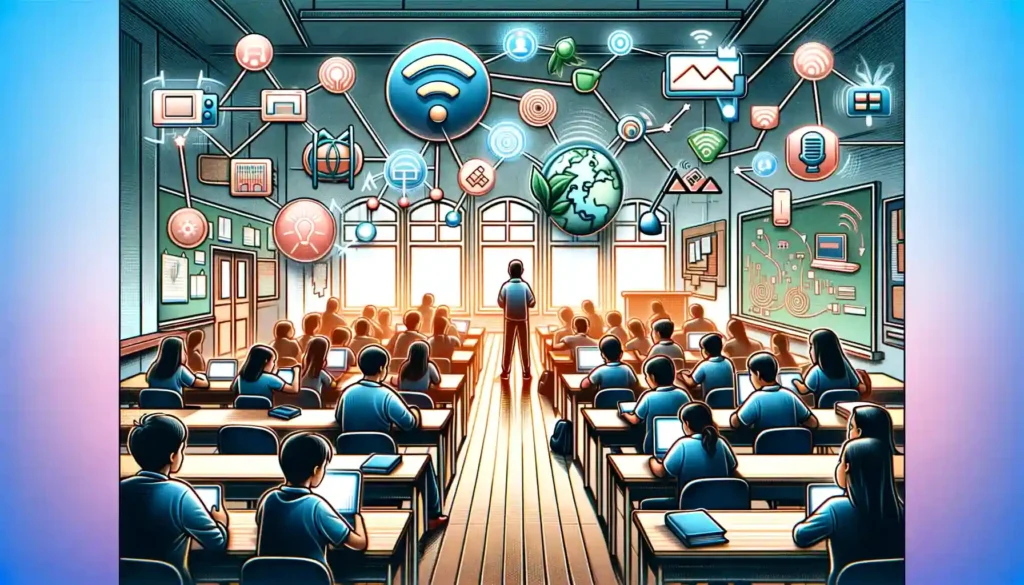
Overcoming Technological Barriers
While IoT offers numerous benefits, it also presents technological barriers that must be addressed. Connectivity issues, compatibility between devices, and the digital divide can hinder the effectiveness of IoT in language learning.
List of Barriers:
- Connectivity Issues: Ensuring stable internet connections for seamless device operation.
- Equitable Access: Providing affordable IoT solutions to ensure all learners have access.
Challenges:
- Infrastructure: Developing infrastructure that supports IoT integration in educational institutions.
- Technical Support: Offering adequate support to assist learners and educators with IoT technology.
Creating a secure and inclusive environment for IoT in language learning involves addressing various challenges and considerations.
The Future of IoT in Language Learning
Predictions and Trends
The future of IoT for language learning is vibrant with possibilities. As technology advances, we can expect to see more sophisticated IoT devices tailored specifically for language acquisition. These devices will likely incorporate advanced artificial intelligence to provide even more personalized learning experiences.
Upcoming Innovations:
- AI-Enhanced IoT Devices: Future IoT devices may feature AI that can understand the context of conversations and provide more natural interactions.
- Augmented Reality (AR) for Language Learning: AR can bring language learning to life by overlaying digital information onto the real world, making learning more immersive.
Preparing for an IoT-Integrated Learning Environment
As we move towards a future where IoT is an integral part of language learning, educators and learners need to prepare for this shift. This means staying informed about new technologies, being open to new teaching methodologies, and ensuring that the necessary infrastructure is in place.
Steps to Integration:
- Professional Development: Educators should engage in ongoing training to stay abreast of IoT advancements.
- Infrastructure Investment: Educational institutions need to invest in the necessary technology and support systems.
Challenges:
- Keeping Pace with Technology: The rapid advancement of IoT can make it challenging to stay current.
- Ensuring Quality: As with any educational tool, the quality of IoT devices and content must be maintained.
In conclusion, IoT holds the promise of transforming language learning in unprecedented ways. By embracing these changes and preparing for the future, we can ensure that learners have the tools they need to succeed in a connected world.
This concludes our comprehensive blog post on IoT for Language Learning. We’ve explored the current state of IoT in education, its specific applications in language learning, the tools and technologies available, the benefits and challenges, and what the future may hold.
As IoT continues to evolve, so too will how we learn and teach languages, opening up new horizons for learners around the globe.
Frequently Asked Questions
What is IoT for language learning?
IoT for language learning refers to the use of interconnected devices and applications to enhance the process of acquiring new languages, making it more interactive and personalized.
How does IoT improve language learning?
IoT devices provide real-time feedback, immersive experiences, and personalized learning paths, significantly improving language acquisition efficiency and engagement.
Can IoT devices help with language immersion?
Yes, IoT systems can mimic immersive language-learning environments, allowing learners to practice listening, speaking, and interacting in real-world scenarios.
Are there any IoT applications specifically for language learning?
Numerous IoT applications like Duolingo and HelloTalk offer tailored language learning experiences through connected devices.
What are the challenges of using IoT for language learning?
Challenges include ensuring data privacy and security, providing equitable access to technology, and overcoming infrastructure and connectivity issues.
What is the future of IoT in language learning?
The future points towards more AI-enhanced IoT devices and augmented reality applications, offering even more personalized and immersive language learning experiences.









Recent Comments